Remember the old saying on the bathroom wall: "no job is finished till the paperwork is done"? The banner above KCA-14 is a reminder of the three year process involved in restoring the paperwork for this airplane...after the actual restoration was complete!
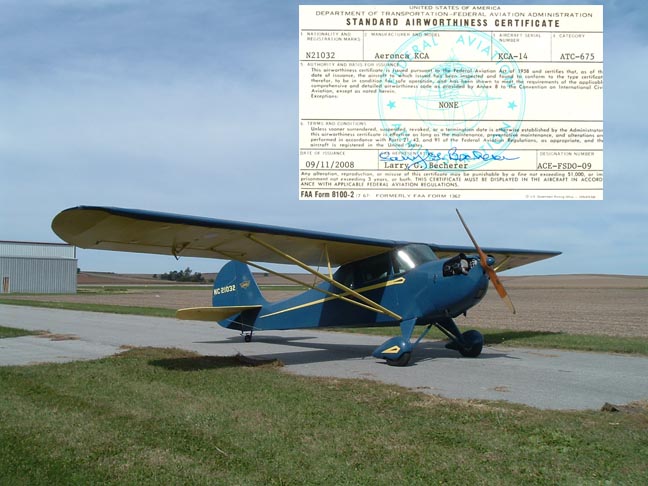
KCA-14; legal at last!
Read more about the paperwork
In 1982, an ad appeared in Trade-a-plane magazine, the yellow aviators' wish book, for this aircraft. It mentioned its antique status, stated a very reasonable price, and promised "easy restoration." The ad remains among the documents preserved with the airplane.
A great fondness for "Cub" type planes has always been mine. The memory of a yellow plane doing loops high above stands out in those many long walks home from country school in the fifties. It was to be a harbinger of things to come. In the sixties, the opportunity presented itself to learn to fly. At the Princeton, Illinois, airport of Marv and Walt May the Aeronca 7AC "Champ" was the trainer of the day. The gentle manners and stark simplicity of that airplane made a believer of yet another student...and the cost was modest.
By the seventies, a Pietenpol project was underway. That is another story to be told. The most rewarding things about its first flight were the familiar flight characteristics and simplicity of operation which it had in common with the Champ and the Cubs which I had since also flown. During the annual pilgrimages to Oshkosh, the Mecca of grass-roots aviators, the forums featuring lightplanes such as the Aeroncas, Pipers, Taylorcrafts and Pietenpols were always priorities.
Fellow enthusiasts shared a kinship as valuable as the ideas and knowledge exchanged. Aeronca club presidents George York and later Augie Wegner opened the exciting world of thirties lightplanes for us...especially the prewar Chiefs which we were assured were "faster than the postwar models." They were also said to have stronger wing spars; a fact which was to come into focus years later when an airworthiness directive (AD) was issued on the postwar spars. It has been some years now since forums on prewar Aeroncas have been held. The postwar Champs and Chiefs are much more numerous due to the boom in production from that period. George admitted to owning several prewar projects including a KCA; a relatively rare model distinguished by a more tapered rear fuselage profile. The word Aeronca is a semi-acronym for the Aeronautical Corporation of America, whose first product was the "C" series or "bathtub" Aeronca of the early thirties. Often pronounced "aeronica," the term has also been mutated into "airknocker." No other company evolved more models in such a few years and only the Waco "three letter" models can cause confusion equal to the early Aeroncas. There was the low wing model "L," that one was easy. Then there was the "K." At one time the "K" had its own Oshkosh forum with the likes of Tom Trainor who acquired the factories' own "K" inventory. His "K" as well as the "C" and "L" models are proudly displayed at Pioneer Airport, Oshkosh.
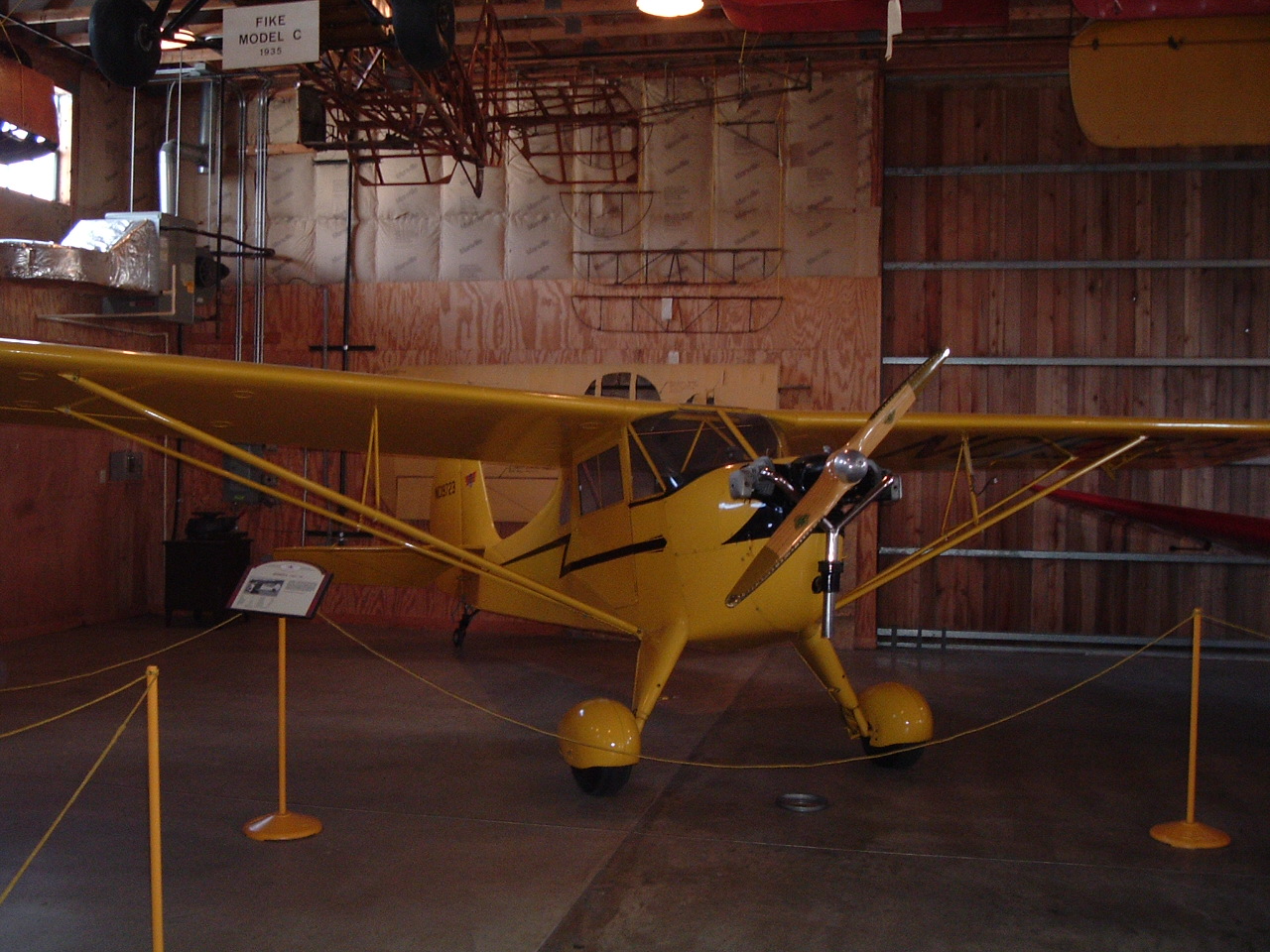
Tom Trainor's Aeronca "K"
Following the "K" was a development encorporating the Continental 40 engine which was called the "KC." Within a year, Continental announced its new "Fifty" engine which endured for decades finally in the form of the O-200. Menasco, Lycoming and Franklin also introduced "fifties" in that year. Aeronca was quick to latch on to this new trend, and the "KC" evolved into the "KM" (Menasco) and "KCA" (Continental) models. By midyear 1938 Aeronca had made all of the above available and introduced a perhaps simpler nomenclature: the Continental powered ship was now the 50-C, with 50-L and 50-F the obvious alternatives. So, the KCA was only a partial-year product with a recorded 62 units built.
But what happened to the 50-M? Therein lies a story. George York told of an Aeronca factory letter sent to KM owners which directed them to "remove the engine and replace it" with one of the other options! The details of why this engine proved unsatisfactory were not specified. Piper advertising for 1938 also listed the Menasco as an option. Years later an article from a period magazine revealed another perspective. Aeronca, the Menasco historian stated, reneged on an agreement to buy engines from them when Continental underbid their price. A reported nine KMs left the factory as such, one is said to survive in California minus its engine. George York also indicated that the aircraft serial number series was shared by the KCA and KM models leaving the possibility that nine less than sixty-two were in fact KCAs. He also pointed out that drawings supplied by the factory to KCA owners seeking them were labeled "KM." This has proven to be true of drawings we have. Another legacy from George was the information that Aeronca engineer John Houser was authorized as part of his job to assist owners with production information and drawings for the early models. The first priority for Aeronca restorers is to secure their "John Houser letter!" This we did and this is still being done by other restorers as of this writing. The letter is a prized part of KCA-14's documentation.

The elusive "KM" (note tail skid)
A Trip to the Sandhills
Could the airplane listed in Trade-a-Plane be one of these rare Aeroncas, and right here in our home state? Merle Hawthorne of the Hawthorne Ranch near Almeria assured us that it was, and invited us to his pasture airstrip to see for ourselves. Metal pole buildings have long replaced barns as the preferred structure for Nebraska farmers and ranchers, but I shamelessly describe my experience of discovery in the classical way..."it was found in a barn!" Mr. Hawthorne was cordial and the transaction was made. "...I maybe should have given it to a museum" he observed. And "Buzz Wagner called about it after I talked to you." Bingo! (Buzz instituted the Aeronca Lovers Club in South Dakota)
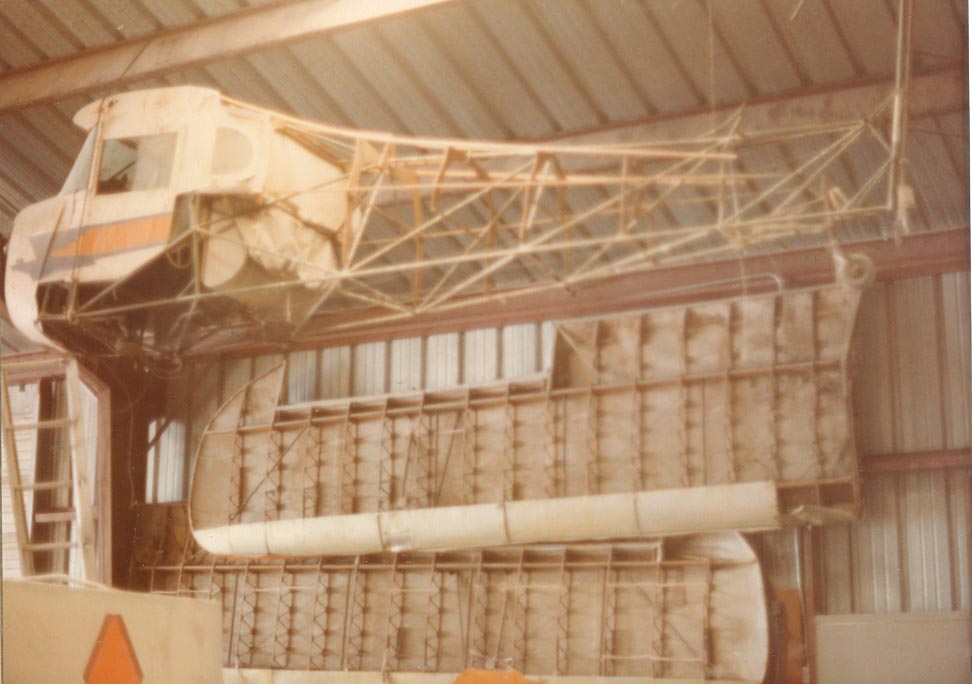
An honest-to-goodness "barn find"
With the project safely moved to garage/skunkworks and before the eager study of accompanying paperwork, we need to tell how KCA-14 came to be hanging in that Nebraska outbuilding. It had come, Merle told us, from California where he bought it. It was a working airplane on the cattle ranch and as such was vulnerable to inevitable incidents of which there were two. The second was dramatic enough to be remembered. A flight to check on some cattle had been made by bright moonlight, but clouds rolled in before the landing. A cow-calf pair made a "runway incursion" and the airplane ended up on its back with bent gear and tail. Facing a second rebuild in its brief Nebraska life, the Aeronca was suspended and its engine pickled in farm style by being filled full of waste oil. This oil still appears from time to time twenty-four years later!
Though it has little to do with airplanes, it cannot go without notice that some years later the Hawthorne ranch became newsworthy as the site of a bizarre murder mystery! Our Mr. Hawthorne had since sold the ranch and moved to the sunny southland, but his successor proved to be one of those belligerent characters who apparently delighted in terrorizing and bullying the rest of the community. At some point, the frontier justice which once characterized all parts of the West made a clandestine return for just one last exercise of its grim necessity. The malefactor was found murdered and no information was provided to investigators by members of the community.
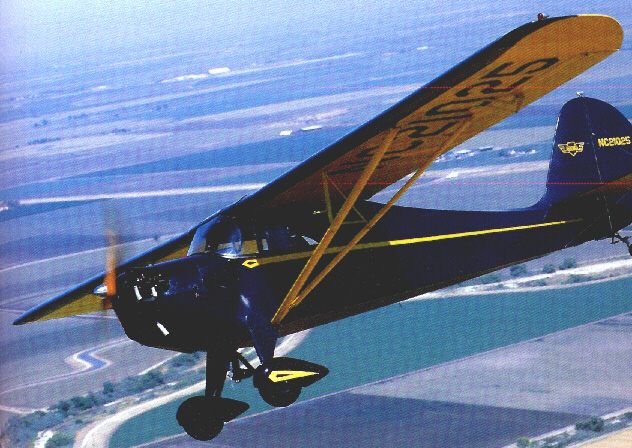
A Recent California KCA, serial number 10
California!
In California, where about half of the surviving KCAs are to be found, our Chief had a series of owners whose trail extended back to World War Two, and slightly beyond. The earliest logs fell victim to the wartime grounding of all coastal private planes...a complete rebuild followed that indignity. But other records survived to tell that Oakland Airport dealer Cory Brayton took delivery of KCA-14 early in 1938. In a month's time he had added steering capability to the full-swivel tailwheel as indicated by a form 337. Next was an upgrade to dual magnetos, from A50-1 to A50-3 status. It may be that this was a kind of dealer demonstator; it is possible that the CAA type certificate was not yet issued.
The aviation world is sometimes a delightfully small universe. Among our treasured aviation magazine collection there is an issue of Western Flying with a picture of Cory Brayton with a trophy he won with a 1938 KCA. The ship in the background is of a different color than ours, however. His Brayton Flying Service also has ads for various KCAs. The California chapter of the American Aviation Historical Society website has links detailing the history of the Oakland Airport from this era. Another Western Flying nugget is the announcement that these new Aeroncas feature "Raymond Loewy styling." This is the only such reference I have seen to date suggesting that the shape of these models was influenced by this most famous of industrial designers.

Cory Brayton and one of his KCAs (without left door option)
The observation of George York was that the 30's Aeroncas were particularly colorful. He also suggested that the decor was of simple, primary colors with no blended shades or pastels common to later times. Our John Houser letter stated that KCA-14 was delivered with blue fuselage and yellow wings and horizontal tail.
The auto manufacturers typically chose a feature color for their new model year's advertising and distributed dealer display cars in this color. Apparently Aeronca did something similar. Virtually all of the California KCAs are blue with yellow wings! The factory pictures, though not in color, appear to be the same. KCs were apparently similarly green and yellow. Ks are uniformly yellow. The tandem model T seems associated with orange. This variety of colors appear across the lines. George York mentioned the popularity of red, and also reminded us that today's showplane finishes were not found on factory products. They were more typical, he said, of what one saw on Maule airplanes of the sixties. There was a deluxe finish option, and this additional dope application remarkably added as much as fifteen pounds to the empty weight. Today the deluxe level of finishing is itself "standard" and one of the subtle ways airplanes gain weight from their original form.
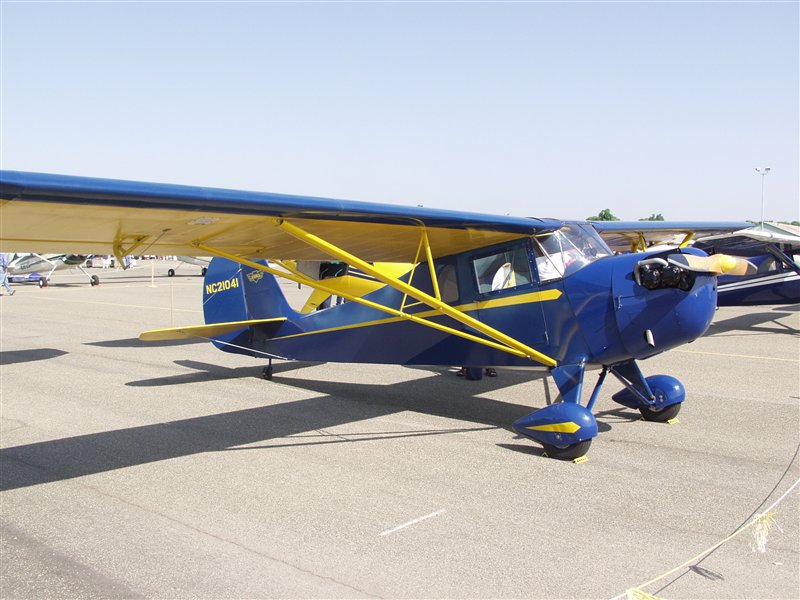
Richard Edmiston's KCA, the most original example in existence
(Thanks for the help!)
An unusual characteristic of Aeroncas was that the wing color was used on the lift struts rather than the fuselage color. Because most other brands followed the opposite scheme, this will strike one as not looking "right." It also means that a small amount of matching enamel will have to be purchased to finish these metal parts while the others will already have enamel in the fuselage color for painting the cowling. Another distinctive of the prewar Aeroncas is the use of aluminum for the lift struts. One of KCA-14's lift struts had been repaired with a steel replacement, which was significantly heavier. Replacement is made easier by the way in which the ends are joined to the wing and fuselage. A bar is inserted in the open lift strut end, and several large rivets hold it in place. These may be replaced by bolts when a new strut is needed. No welding. There is little danger of a Piper-type lift strut issue. The bolts attaching these struts to the wing and fuselage appear about double in size to the Cub's. The same might be said of the landing gear attach bolts.
The way in which Aeroncas travelled to California in those days was by boxcar. There is a picture of one such sister ship being loaded at the factory in one of the Aeronca books.

There's just a chance this could be KCA-14!
(from Hollenbaugh & Houser, "Aeronca, A Photo History")
Continuing with the aircraft paperwork survey, a rebuild of the wings is cited, with replacement of rib gussets with one-sixteenth inch plywood. It was another characteristic of prewar models that the reinforcement of rib members at their joints was done with a fiber material commonly called "fishpaper." Examination of the wings of KCA-14 showed that indeed most of the gussets had been replaced, but at the rear member of the aileron bay ribs some were retained. They have been preserved in case someone would like to see just what they were like. Someone went to the trouble to assess the weight savings these gussets afforded, and the result was six pounds.
Like all fabric airplanes, KCA-14 had a series of partial and complete recovering jobs. The most recent was a complete synthetic fabric application using the Stitts process and a custom paint scheme of white with orange and blue trim. There were several other modifications to the airplane through the years. A ten gallon auxiliary tank was substituted for the original five gallon one. There was such a tank offered as an option on 1941 models. This unfortunately places the filler neck on the right side instead of the original left side location. A wobble pump on the cabin floor between the seats moves the fuel from this tank to the fuselage tank in the nose. This was one of the desireable original parts in the airplane. In the KCA this remains a ten gallon tank as in the K; it was increased to twelve in the model 50-C.

Showing aux tank, wobble pump on floor, selector switch, front tank
Also in California a Beech-Roby controllable pitch propeller was added. The instrument panel was built up to include more instruments such as cylinder head temperature, manifold pressure, clock and turn-and-bank. An 11AC cowling replaced the original. Previous owners reported the plane flew well in this configuration although weight had increased considerably. There are no factory records available on upholstry colors and materials for specific planes, so the existing scheme was recreated with treated cloth and vinyl in blue. The white vinyl headliner which had a "fifties" look was replaced with gray material. Some rear side window glass remained imbedded in the covering and headliner, badly discolored and misshapen with the years. This material has been greatly improved with the introduction of plexiglas, which was used to replace it. Window channel in the doors was corroded and an exact duplicate in stainless was found in the J.C. Whitney catalog, proving the axiom that every plane restoration has something from J.C. Whitney in it. The plywood floor board and fuel tank support were of three-ply material painted black as indicated by factory records (Berryloid enamel), they were replaced with new material. The black original carpet was conventional loop easily duplicated. The heel plates were replaced. The panel was restored to the original large tach cluster and two flight instruments, airspeed and non-sensitive altimeter. Richard Edmiston provided metal placards he had made for his project for the panel. The panel was finished in blue crackle paint per original design. Individual seat belts with metal connectors were added according to present safety regulations. A contemporary version of the small fire extinguisher was attached to the floor ahead of the seat. The sling type seat has a removeable bottom cushion for parachutes and is only 34 inches wide, same as the K. Later models were widened.
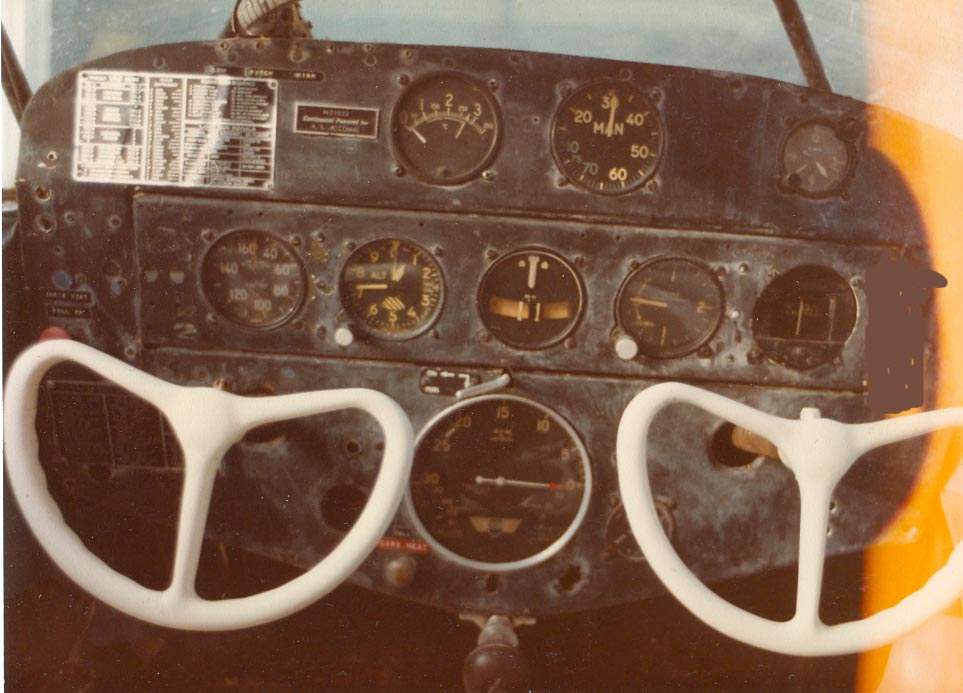 _
_
Old and new panels
Along the course of this long project, a windfall came in the form of an ad in Trade-a-plane for a set of original prewar Chief drawings from an enthusiast in Canada. These provided basic drawings which were particularly helpful in the case of the wings. Rib spacing was called out exactly, and this proved very valuable for dodging the many obstacles inside the wings. One question remains to be answered in this connection, and that is whether in 1938 Aeronca used drilled bolts with castle nuts in the wing hardware. The wings on our plane had been rebuilt, and had bolts with elastic stopnuts throughout. The common wisdom is that elastic stopnuts came after the war only. It is true that all the fuselage hardware featured drilled bolts and castle nuts on our plane as we found it. We replaced all wing hardware with drilled bolts. A rib jig was constructed and all new ribs built and dipped in spar varnish with anti-fungicide added.

Wing ribs being dipped in spar varnish with pentachlorophenol
New spars from Wicks were lined up with the old ones and drilled with Forstener bits. We have the originals for patterns should someone need them. The metal fittings were in great shape and were cleaned and zinc chromated. Prewar Chiefs are among the few planes using 3/32 inch control cables to the wings and rudder. These were the originals on our plane as proven by the fact that they did not have nicopress ends on them, but were finished with five-tuck hand splices. After much practice and poring over several prewar mechanics' manuals, we duplicated the five-tuck splice on every cable on the airplane.
The Army-Navy five tuck splice
The drawings noted an interesting list of options for leading edge material, including pierced steel (like the radiator covers in old houses)! We made a bending jig and used .016 alclad from K.C. Airparts at the Oshkosh flymarket. Wings take up a lot of space, and we approached this problem by hanging them from pulleys on the ceiling or in vertical stands.
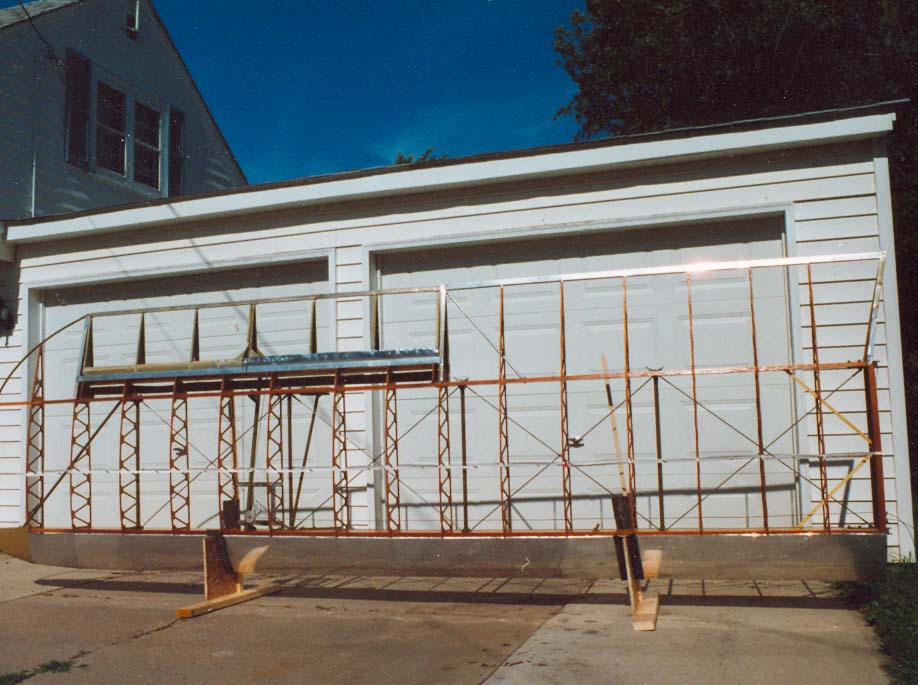
Wing ready to cover
Fuselage Restoration
The existing firewall was beautiful stainless steel with the factory bronze paint on the rear, but penetrated by too many holes through the years for such things as the prop control. It could be salvaged by replacing only the small doghouse that provides space for forward travel of the control yoke assembly. There were four bolts on the firewall which held the oil tank on the original, rare A-50-1 dry sump arrangement. The original glass gascolator remained, but had been mounted inverted for clearance problems. This was rotated to the correct position. No provision for quick-drain existed originally. If you could see water, you took off the bowl. Early factory advisory letters to owners (today we would call them A.D.'s) complicated this by suggesting the gascolator bowl starwheel be drilled and safety-wired. Another letter addressed the problem of tailwheel shimmy, with a drawing illustrating how to install a damper at the top swivel of the bungee tailwheel assembly. These first modifications to our plane while it was still in the hands of Cory Brayton also were to make the tailwheel steerable and to change from single mag to dual mags. 1938 was the only year for this bungee-type tailwheel and some KCAs were changed to the later leaf spring tailwheel. This is easily seen on pictures and a prime indentifier distinguishing the KCA. There are pictures of some later models, even 39's, with bungee tailwheels but one would think they were factory prototypes perhaps. Another visual clue is that there is only one fuselage side stringer running from the door to near the tail on the KCA. 50's and later have two or more such stringers which usually show well through the fabric. Since the tailwheel is so distinctive, we sent a letter describing it to the Aeronca magazine which they published. I was pleased that there was no shimmy with the tailwheel.
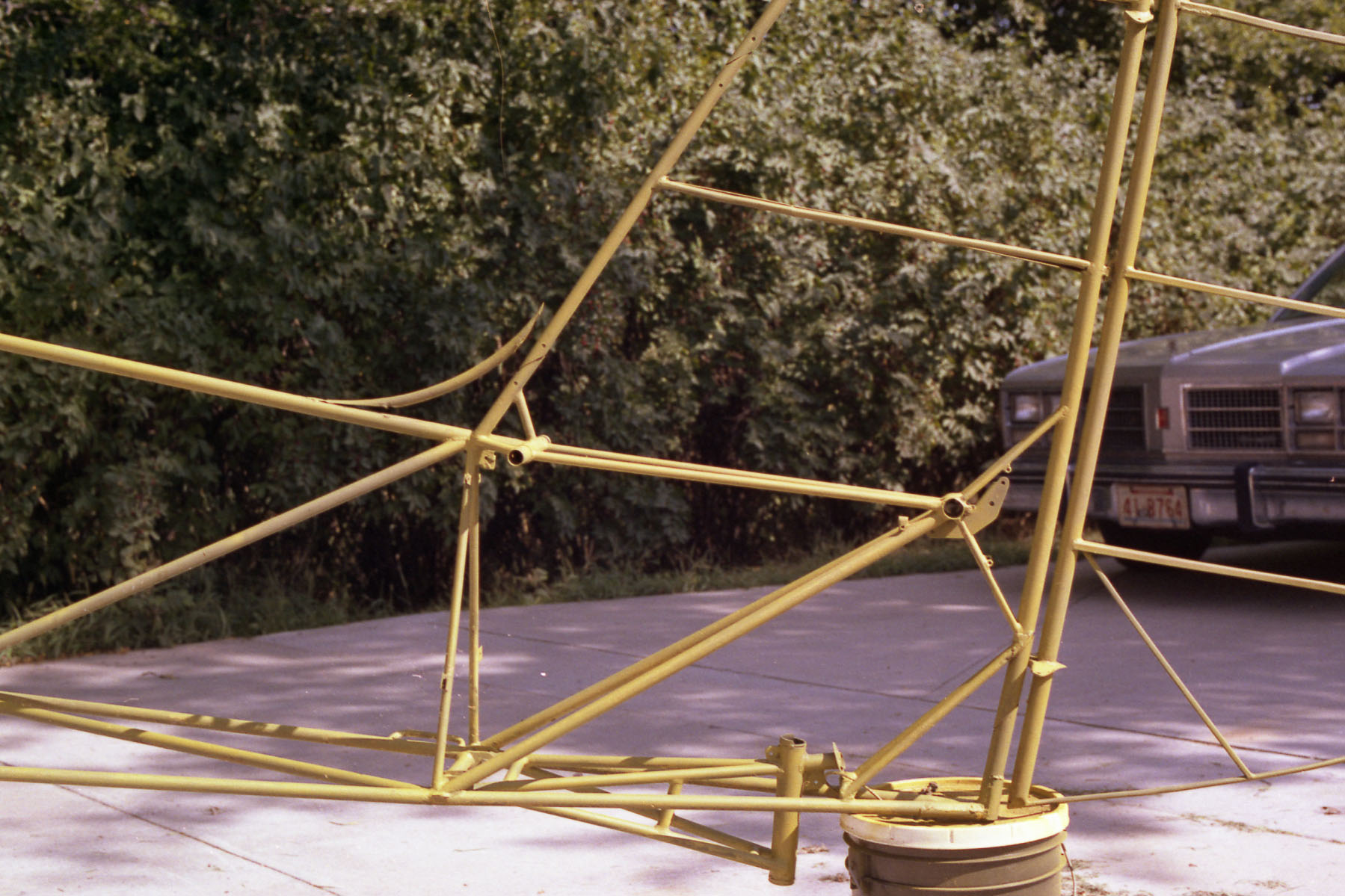
Tailwheel assembly
To keep a project such as this affordable, the biggest savings are probably to be realized in doing one's own recovering job. But there are also significant savings available in the landing gear area. Rebuilt oleo struts are advertised at a price far beyond what one would expect, but may not be necessary. With the oversight of our friendly A and P mechanic, we took apart and cleaned these struts following the factory letter which covers them. By looking up into the fluid filler holes in the bottom, one can tell if they have metal pistons...they will be shiny. Some early pistons were micarta (plastic) and if they failed, allowed the struts to pull apart and the gear to fall out. This was the original reason for the snubber cables linking the axles to the oleo frames. But there is another issue. The whole oleo shock strut is held in the case with a quarter inch bolt through the top of the case...one you can see from the outside. What you can't see is if this bolt is actually going through the shock strut or has missed it on its top! The factory letter suggests lifting one side of the plane up and standing on the wheel to be sure. This can easily happen and is another reason to put on the snubber cables. That quarter inch bolt goes through a bushing in the oleo shock strut which wears and causes looseness in the gear. I have heard forum speakers warn that this bushing must be produced on a lathe and be custom fit (the speaker was a provider of this service}. I found that a section of steel brake line from the auto parts store worked just fine. The packing rope in the strut can be reused. My gear does not rumble, works properly and does not leak. It is remarkable that this gear was used all the way up to the early Citabrias!
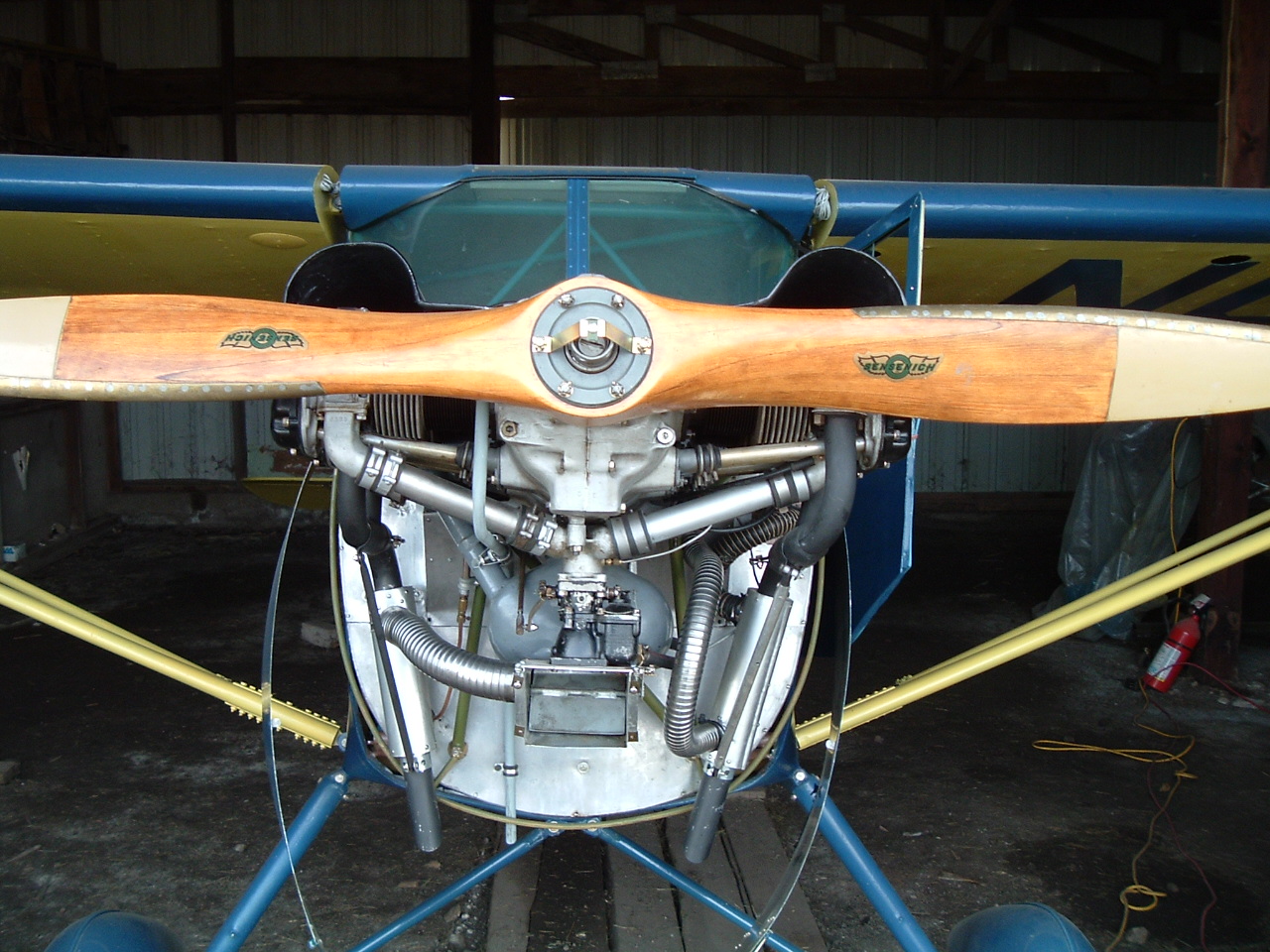
The third engine in the story was the one which appeared on KCA-14 in one of its California rebuilds. This was the A-50-9 with the Beech-Roby prop. This engine has the starter pad on the rear case and mags mounted in horizontal position. It has the kidney oil tank and bottom exhaust. The logs for this engine reveal that it originally powered the last experimental Welch OW monoplane! Another very rare item.



KCA-14 at the time of its first flight after restoration. On that day a sixty-three year old enthusiast flew a sixty-eight year old plane after a twenty-four year project!